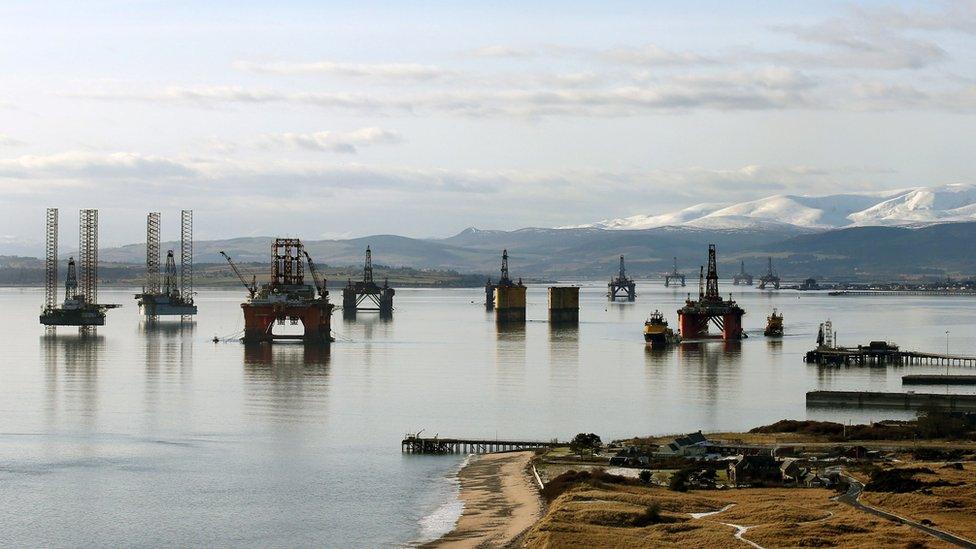Independence Day: What if?
- Published

The GERS report showed that spending had been higher than previously thought
The Holyrood election campaign is about the question "what next?" But as MSPs lose the letters after their names and "go to the country", it starts with a big "what if?"
That's because Thursday 24 March 2016 was pencilled in during the referendum campaign as "Independence Day".
Had there been a majority "Yes", the subsequent 18 months and six days would have been rather busy for Whitehall and St Andrew's House negotiators.
They would have been cutting deals, and preparing the ground for a big party, probably including some fireworks, to mark the birth (or re-birth) of Scotland as an independent nation.
Those 18 months have seen some significant change, not least in the economic outlook. They happen to have coincided with the downturn in the oil price, and the collapse of UK oil revenues.
Oil flow reversed
UK growth is slowing, according to the Office for Budget Responsibility (OBR). In Scotland, the slowdown has a lot to do with the oil and gas sector. It's feeling the pain, and sharing it around a bit.
We've recently been given, by the Scottish government, updated numbers on recent years' out-turn of Government Expenditure and Revenue Scotland (GERS). They showed spending has been higher than previously thought.
Using the OBR and GERS numbers, the IFS - or Institute of Fiscal Studies - has run the numbers on future projections for Scottish finances, external. That's if they are stripped out of the UK's and a large dollop of oil revenue is added.
Except that it's no longer added: it's being taken away. Through low or no profits and investment tax breaks, the latest forecasts for UK oil and gas revenues are negative, and mean tax giveaways averaging £800m over each of the next few years.

So where does the IFS show a notionally independent Scottish nation to be on Independence Day-minus-one? Full of optimism, perhaps. But financially, deep in the red.
Next financial year, 2016-17, was seen until recently as having a UK deficit of 2% of Gross Domestic Product (GDP, or national output). But with the slowdown in growth and following George Osborne's Budget choices (yes yes, I know - more on that later), the OBR reckons that is now looking more like a 2.9% deficit.
And while the parallel Scottish deficit, under previous assumptions about growth and revenue, was calculated by the IFS at 6.8% of GDP, that has gone up to 9.4%.
To be clearer, that means that the Scottish state would be £10.6bn further into the red than the UK. The previous forecast was an additional spending gap of £8.2bn next financial year.
Looked at another way, it means that for every £1,000 earned across the whole Scottish economy, the government would have to borrow £94 in order to sustain its spending levels.
Health warnings
So yes, the UK is still in the red. The Scottish share per head of George Osborne's continuing deficit is reckoned by the IFS to be about £850 next financial year.
On top of that, the new calculations point to a deficit of about £2,000 per Scottish skull.
And so it continues. George Osborne is trying to get the UK government deficit down to zero and into surplus by 2019-20. That's what "austerity" is all about.
If his plan works, the Scottish share of that deficit would also fall. But the gap between relatively high spending in Scotland and the country's lower tax capacity means that the gap gets at least £500m bigger each year.
By 2020, using OBR forecasts that put the UK into a small surplus, the IFS tells us that implies a 6.2% deficit in Scotland, or £12.2bn. Its previous forecast was for £9.7bn that year.
Either way, these are big numbers. That most recent forecast is for a sum close to the amount spent each year on the health service in Scotland.

The party leaders posed for a selfie following the dissolution of the Scottish Parliament
There are lots of health warnings should be issued alongside these new numbers.
One is that the OBR can and does get its forecasts wrong. It assumes no change to the share or direction of Scottish spending or taxation.
It also fails to take into account the mess that has already been made of George Osborne's planning by the rapid dismantling of parts of his Budget under political pressure. It's hardly the first time he's been knocked off course.
These numbers assume that Scotland's growth rate continues to be constrained, particularly by the problems facing the oil and gas sector.
But it's possible that the growth rate could be boosted by the next Scottish Parliament, and its use of newly devolved tax powers.
Once this "what if?" independence question is parked - at least until the SNP campaign for it re-starts in summer - boosting the growth rate is one of the challenges on which the Holyrood campaign can focus.